
It was a foggy, drizzly Sunday, so with great pleasure I went back into bed with a good book (review to follow) and a nice cup of tea.
This got me thinking about how much I love my tea and how picky I’ve become about tea preparation. I guess it’s time to admit, I’m a tea snob… I know annoying, right? Put me in a typical American breakfast joint and I can tell by a few questions to the wait person how they prepare their tea and whether or not I will order any. “Do you serve your tea in a tea pot?” “Does the water come from the coffee maker?” “Do you bring the tea bags on the side or in the pot?” My table companion(s) just shake their heads and pretend not to know me.
It always comes as a surprise when I see how my fellow Americans approach tea at home — a bag in a cup of microwaved water? I mean really – no tea pot? no tea kettle?
So my own tea prepared at home is my delight. First it has to be a good strong British tea. Yorkshire Gold, Barry’s Irish Breakfast, PG Tips are favorite everyday teas. Often however, when we travel I always seek out local tea shops and buy loose teas – Murchies on Victoria Island in BC, Canada was my most recent splurge (their Prince of Wales tea is excellent). These fancy teas I prepare on weekends, as a treat.
Then if I’m feeling especially British, I will use one of my proper tea cups and saucers rather than my typical weekday “reading” mug.
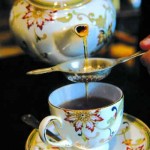

But then, this morning, quite serendipitously, I found the following article from George Orwell and in my head I cried “comrade”. I have a few differences with his tea preparation – six teaspoons of tea to a quart pot seems excessively strong, even for me… but nonetheless, here is tea snobbery at its best.

(Orwell with a Nice Cup of Tea)
A Nice Cup of Tea by George Orwell First published in The Evening Standard, January 12th, 1946
If you look up ‘tea’ in the first cookery book that comes to hand you will probably find that it is unmentioned; or at most you will find a few lines of sketchy instructions which give no ruling on several of the most important points.
This is curious, not only because tea is one of the mainstays of civilisation in this country, as well as in Eire, Australia and New Zealand, but because the best manner of making it is the subject of violent disputes.
When I look through my own recipe for the perfect cup of tea, I find no fewer than eleven outstanding points. On perhaps two of them there would be pretty general agreement, but at least four others are acutely controversial. Here are my own eleven rules, every one of which I regard as golden:
First of all, one should use Indian or Ceylonese tea. China tea has virtues which are not to be despised nowadays — it is economical, and one can drink it without milk — but there is not much stimulation in it. One does not feel wiser, braver or more optimistic after drinking it. Anyone who has used that comforting phrase ‘a nice cup of tea’ invariably means Indian tea.
Secondly, tea should be made in small quantities — that is, in a teapot. Tea out of an urn is always tasteless, while army tea, made in a cauldron, tastes of grease and whitewash. The teapot should be made of china or earthenware. Silver or Britanniaware teapots produce inferior tea and enamel pots are worse; though curiously enough a pewter teapot (a rarity nowadays) is not so bad.
Thirdly, the pot should be warmed beforehand. This is better done by placing it on the hob than by the usual method of swilling it out with hot water.
Fourthly, the tea should be strong. For a pot holding a quart, if you are going to fill it nearly to the brim, six heaped teaspoons would be about right. In a time of rationing, this is not an idea that can be realized on every day of the week, but I maintain that one strong cup of tea is better than twenty weak ones. All true tea lovers not only like their tea strong, but like it a little stronger with each year that passes — a fact which is recognized in the extra ration issued to old-age pensioners.
Fifthly, the tea should be put straight into the pot. No strainers, muslin bags or other devices to imprison the tea. In some countries teapots are fitted with little dangling baskets under the spout to catch the stray leaves, which are supposed to be harmful. Actually one can swallow tea-leaves in considerable quantities without ill effect, and if the tea is not loose in the pot it never infuses properly.
Sixthly, one should take the teapot to the kettle and not the other way about. The water should be actually boiling at the moment of impact, which means that one should keep it on the flame while one pours. Some people add that one should only use water that has been freshly brought to the boil, but I have never noticed that it makes any difference.
Seventhly, after making the tea, one should stir it, or better, give the pot a good shake, afterwards allowing the leaves to settle.
Eighthly, one should drink out of a good breakfast cup — that is, the cylindrical type of cup, not the flat, shallow type. The breakfast cup holds more, and with the other kind one’s tea is always half cold before one has well started on it.
Ninthly, one should pour the cream off the milk before using it for tea. Milk that is too creamy always gives tea a sickly taste.
Tenthly, one should pour tea into the cup first. This is one of the most controversial points of all; indeed in every family in Britain there are probably two schools of thought on the subject. The milk-first school can bring forward some fairly strong arguments, but I maintain that my own argument is unanswerable. This is that, by putting the tea in first and stirring as one pours, one can exactly regulate the amount of milk whereas one is liable to put in too much milk if one does it the other way round.
Lastly, tea — unless one is drinking it in the Russian style — should be drunk without sugar. I know very well that I am in a minority here. But still, how can you call yourself a true tea-lover if you destroy the flavour of your tea by putting sugar in it? It would be equally reasonable to put in pepper or salt. Tea is meant to be bitter, just as beer is meant to be bitter. If you sweeten it, you are no longer tasting the tea, you are merely tasting the sugar; you could make a very similar drink by dissolving sugar in plain hot water.
Some people would answer that they don’t like tea in itself, that they only drink it in order to be warmed and stimulated, and they need sugar to take the taste away. To those misguided people I would say: Try drinking tea without sugar for, say, a fortnight and it is very unlikely that you will ever want to ruin your tea by sweetening it again.
These are not the only controversial points to arise in connection with tea drinking, but they are sufficient to show how subtilised the whole business has become. There is also the mysterious social etiquette surrounding the teapot (why is it considered vulgar to drink out of your saucer, for instance?) and much might be written about the subsidiary uses of tealeaves, such as telling fortunes, predicting the arrival of visitors, feeding rabbits, healing burns and sweeping the carpet. It is worth paying attention to such details as warming the pot and using water that is really boiling, so as to make quite sure of wringing out of one’s ration the twenty good, strong cups of that two ounces, properly handled, ought to represent. Thanks to Kate Davies for this post.
+++++++++++++++++
So readers, what’s your snobbery all about?
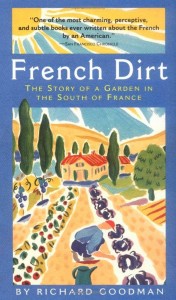 Richard Goodman saw the ad in the paper: “SOUTHERN FRANCE: Stone house in Village near Nimes/Avignon/Uzes. 4 BR, 2 baths, fireplace, books, desk, bikes. Perfect for writing, painting, exploring & experiencing la France profonde. $450 mo. plus utilities.
Richard Goodman saw the ad in the paper: “SOUTHERN FRANCE: Stone house in Village near Nimes/Avignon/Uzes. 4 BR, 2 baths, fireplace, books, desk, bikes. Perfect for writing, painting, exploring & experiencing la France profonde. $450 mo. plus utilities.
And so, with his girlfriend Iggy, he leaves New York City to spend a year renting a two hundred year old stone house in Southern France. Located in a small village fictionally called St. Sebastien de Caisson, it doesn’t have a cafe, store or even a post office. Starry-eyed, Richard and Iggy soon discover they are having a tough time connecting with the locals. Out of necessity, Richard works in a vineyard in exchange for firewood. In the vineyard, he forms a solitary friendship with Jules, a handsome 25 year old, and through that relationship Richard borrows a small plot of land. Having a difficult time making friends in his little village, Richard determines to make a vegetable garden instead.
Oh no, you say, not another “my experiences in France book” — trust me, this one is different — part travelogue, part gardener’s journal, part pilgrimage and wholly enjoyable. I read French Dirt when it was first published in the 90’s and remember it fondly. It has recently been republished with a pretty new cover (shown here) and when I picked it up in the bookstore, I remembered I still had my copy lurking in my towering chaos collection of books. I dug out my older copy (Yes, I knew right where it was – I’m a “rainman” when it comes to locating my books) and re-read French Dirt over the last two evenings.
What sets this tale apart from the plethora of “my life in France” books, is that Richard is such a hapless American on so many levels. His plans for his garden, forming friendships with the locals, and settling in to a new life often go awry. You chuckle and wince as he binge-buys plants and tries to sort out conflicting advice from the villagers — but then you cheer as he toils and worries over his garden, delights in its growth and is distraught by his garden disasters — all while the neighbors politely hide their amusement at the silly American.
It’s not all fun and games, there is quiet despair as Richard struggles to master the ancient house repairs and loneliness when they are housebound during an endless number of rainy days. But as his garden grows, slow friendships also develop. There is a heart-warming and funny description of a prank in which one of the least likely villagers secretly places perfect red, ripe tomatoes in his garden in early June.
Happily, the book does not parody the villagers — there are no caricatures of French people – they are treated gently and with respect in this memoir. And while Richard struggles and fails, he never feels sorry for himself or blames others. He is open and honest with his own shortcomings. Richard is also serious and perhaps even somber as he recounts the backbreaking hours in the brutal Southern French sun — all for a beloved garden which he knows he must abandon at the end of the year.
He writes; “I would crouch down on one knee, thrust my hand shovel in and turn the earth up and over, revealing its darker, humid underside. Then I would crumble it slowly in my hands to better allow the plant to breathe. In that sense I had a comradeship with the earth: I must be able to breathe, too.”
No question that this is a “gardener’s tale” — if you are not interested in gardens or gardening – this may not be a book for you. And admittedly, the writing is often far from perfect, but you won’t mind as Richard’s story is heartfelt and true.
French Dirt is a gentle adventure of sorts — the American as an immigrant and the searching for a new identity in an old place. If like me, you ever daydream, even just a little bit, about moving to a foreign country – this is a perfect afternoon-in-the-hammock summertime read.
Save

Courtesy of Beulah Maud Devaney of The Toast
In your previous life you were a medical practitioner and accidentally killed a patient while drunk. Since then you have stopped drinking, changed your name to something with the same initials as your previous name, and moved within 5 miles of the original murder. You have also married the dead patient’s spouse.
You have received a letter from a recent murder victim. You read half of it before stopping to inform your guests and entire staff about the letter. You then wander off to read the rest in your study, next to your collection of antique blowpipes.
At dinner you decide to tell a lighthearted story about a gruesome murder. The murderer escaped but had an unusual physical defect by which you would be able to identify them anywhere. You refuse to disclose any more details but glance meaningfully around the table before heading up to bed.
You noticed something odd at dinner but can’t work out what it was. You informed the table of this and then wandered off to the summer house for a nap.
You began life as a homeless street urchin but, in a vulgar retaliation against your social position, you built your own business empire and now own all of New York.
You have a dazzling cousin with a boy’s name who wears short dresses and enjoys midnight swimming with your fiance. She appears to be in danger of being murdered. You have invited her to stay with you.
You are surrounded by foreigners.
You have a maid called Hilda, Tilda, Greeta, or Gretel who you are horrible to. She has ugly glasses and watchful eyes.
You suspect that a murder has been committed so you tell no one and invite the murderer to dinner.
You have a much younger husband. You met him on a cruise just two weeks after your husband died. Your family doesn’t like his paintings.
Your husband has died after drinking a poisoned cup of tea that only you and one other person could have prepared for him. You continue to doggedly drink tea and claim the whole thing is a misunderstanding.
You are a handsome woman.
You agreed to divorce your wife months ago, but she keeps sending detectives to ask you for a divorce and some of your personalized writing paper is missing.
You organize a big family gathering and use it to insult all your guests. You then whip out your will and alter it at the dinner table while everyone finishes their semolina pudding.
Your mousey little wife is extremely unattractive (those glasses! that schoolgirl bob!) but also bears a passing resemblance to the glamorous film star you are having an affair with.
Worried that your past is catching up with you, you have decided to fake your own death with the use of a dead tramp.
You receive a vaguely lewd poison pen letter and decide to have a bridge party to celebrate.
One of your neighbours accidentally donated a priceless work of art to the vicarage jumble sale. You brought it on a whim and are now drinking tea beneath it.
You are traveling to meet your young lover when you notice your estranged husband getting on the same train. You assume last night’s ugly scene (where you told him about Alfredo’s sensuous spirit) has been forgotten and he is taking a spontaneous business trip.
You insist on dropping hints to your guests about Bunny’s “frightfully interesting time during the war.” Bunny is glowering.
You are being blackmailed by a swarthy fellow. Rather than give in to his demands you make a speech about good old England and then turn your back to write a note to your tailor.
You habitually wear dark glasses, big hats, false teeth, bulky coats and speak with a unique yet easy to mimic accent. All of your friends, family and staff used to be on the stage.
Everything tastes horrible.
Everyone hates you.

Thank you, Mom
Happy Mothers Day.
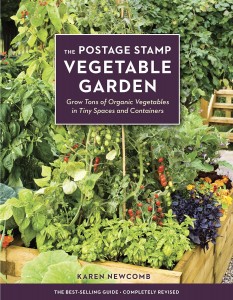 What, you say — a gardening book? Who sits down and reads a gardening book? True confession time, I do. This guide turned out to be ideal for my city-small garden and my raised vegetable growing beds.
What, you say — a gardening book? Who sits down and reads a gardening book? True confession time, I do. This guide turned out to be ideal for my city-small garden and my raised vegetable growing beds.
The book opens with this great passage:
It’s a beautiful day. There’s not a cloud in the sky. The temperature is in the mid-80s. And there you are in your backyard, picking loads of vegetables from your own small garden tucked away in the corner of your property. Tomatoes, onions, corn, beans, you’ve grown them all—in fact, more than you ever dreamed possible from such a small space.
Impossible?
Of course not. That’s exactly what a postage stamp garden is intended to do and what you will learn to do in the next several chapters. The techniques outlined here allow you to double or triple the quantities of vegetables you might normally grow in any given space.
First published 40 years ago, in this newly revised edition, Ms. Newcomb introduces us to a radical style of gardening tailored for “postage stamp” or small space gardens. She advocates planting seeds much closer than recommended on the seed packets, with no neat rows and succession plant so you have crops all year round (depending on your location).
She goes on to explain the history of this technique.
The history of this incredible gardening system began in the 1890s. Outside Paris, a few enterprising Frenchmen began raising crops using a new method they discovered. Over their land they spread an 18-inch layer of manure (plentiful in the day of the horse and buggy) and planted their vegetables so close together in this rich material that the leaves touched one another as the plants grew. Under this carpet of leaves, the ground remained moist, warm, and vigorous. During periods of frost, they set glass jars over the tiny plants to give them an early start. So good were the Frenchmen in devising fresh ways of growing things that they were able to produce nine crops a year. Such was the birth of the French Intensive method of gardening, an early form of what we now call intensive gardening.
The benefits of this technique, besides year-round vegetables, are quite attractive — you need less water (key here in California) and it requires less weeding (hear-hear!). Not to say that postage-stamp gardening doesn’t have it’s challenges – it does — but they are clearly and simply explained in this book.
She makes it easy to understand her concept of “crop stretching” — that is, when succession planting in an area that has frost and winter (poor you) you should alternate your crops – early spring planted crops (spinach) are replaced by later crops (beans). Also, if you’ve just harvested slow-growing crops (broccoli) in late summer you now have a short growing season left, so plant a quick maturing crop such as green onions. If your garden is in a temperate climate (like mine) you can plant the same crops in succession all year long (as with lettuce or spinach). She goes on to explain “intercropping” — planting quick maturing crops between slower maturing crops. You harvest the intercrops before the maturing crops have grown big enough to crowd the smaller plants out. That’s getting double duty out of your postage stamp bed.
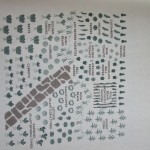 The author has given detailed drawings of sample garden layouts, (sorry for the poor photo) there are several designed to fit a 4×4 bed. Look at all the produce! Click to make larger.
The author has given detailed drawings of sample garden layouts, (sorry for the poor photo) there are several designed to fit a 4×4 bed. Look at all the produce! Click to make larger.
The last half of the book is filled with a vegetable by vegetable guide – Ms. Newcomb recommends heirlooms and gives a cute little postage stamp rating (1 to 4 stamps) to indicate which are best for postage stamp gardens. And each section gives crop stretching advice — “you can follow beans with a planting of cabbage…”
There are additional sections covering: Plants That Like Each Other; Herbs; Companion flowers; Composting and Pest Control.
After reading this book, I felt like a beginning gardener all over again. Turns out I’ve been doing it all wrong — plant my vegetables once (or twice) during the year, always in neat rows, thin the small seedlings, and rejoice over what now appears to be very paltry results.
So, if you have a small garden or don’t want the work of a larger one, this is the book for you.
Now, if you’ll excuse me, I have seeds to plant.
Overheard in the bookstore the other day:
“Have you read this? It’s wonderful.”
“I don’t read novels, when I read I want to learn and educate myself.”
I’ve heard variations on this opinion before from smart and respectable non-fiction-only readers and I always nod and smile. In truth, however, I have to quell the urge to grab them by the arm, march them into a comfortable chair, give them a cup of coffee and demand they read an author such as Nicole Mones.
A newly launched textile business took Nicole Mones to China for the first time in 1977, after the end of the Cultural Revolution. She traded textiles with China for eighteen years before she turned to writing. Ms. Mones’ extensive knowledge of China’s culture, history and politics is woven throughout her books. Her novels are enthralling, but each one is an education as well. Ms. Mones is an author who obviously understands that there are readers who want to think and be entertained at the same time.
++++++++++++++++++
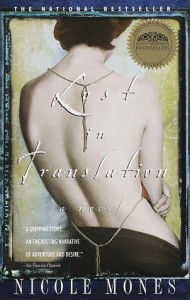 Lost In Translation, Ms. Mones’ debut novel takes the reader into the world of Alice, an unlikeable American woman living in contemporary China. Alienated from her Congressman father because of his overt racism, Alice seeks to leave America behind and become Chinese. She works as a translator by day and secretly haunts bars at night often having one night stands with Chinese men – trying to understand and connect with the xenophobic culture.
Lost In Translation, Ms. Mones’ debut novel takes the reader into the world of Alice, an unlikeable American woman living in contemporary China. Alienated from her Congressman father because of his overt racism, Alice seeks to leave America behind and become Chinese. She works as a translator by day and secretly haunts bars at night often having one night stands with Chinese men – trying to understand and connect with the xenophobic culture.
But things change for Alice when she accepts a translator position with an archeological team tracking the remains of the ancient and important Chinese treasure — “the Peking Man”. Alice becomes close to Lin a member of the team, while they navigate mysterious secret meetings and the threat of arrest. Working with Lin, she forms a close connection and better understanding of Chinese culture and history
The novel not only mesmerizes with the fictional characters and storyline, but goes further to weave in the historical significance of Peking Man as the first ancestor of China and the important writings of the French Jesuit priest-philosopher, Tielhard de Chardin, from whom the archeological team gains clues as to the whereabouts of the bones. This novel has it all – an engrossing mystery combined with Chinese cultural history and a dash of sex and romance.
The title* captures the gist of the novel, namely the difficulties of trying to move between cultures, language, history and current society — never being sure what has been lost in translation. (*No relation to the Bill Murray film of the same name.)
+++++++++++++++++++++++
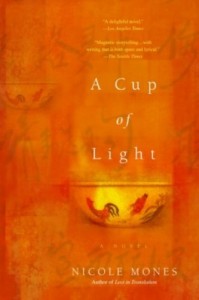 A Cup of Light transports us into the rarefied world of Chinese porcelain “pots” long treasured by emperors and collectors alike.
A Cup of Light transports us into the rarefied world of Chinese porcelain “pots” long treasured by emperors and collectors alike.
Lia Frank is an American appraiser of fine Chinese porcelain and is sent to Beijing to authenticate a collection of rare pots going up for international sale. As she unpacks the crates, holding each delicate piece and “feeling” the refined porcelain, she discovers there are many more pots than originally estimated and that some of them are “fakes”. But these are no ordinary fakes –these are forgeries so exquisite, so precise that she has to find the forger. In Chinese culture when the copy is as beautiful as the piece it imitates then the forgery and the forger are greatly admired.
Again an education here — with A Cup of Light you’ll discover the infamous Chenghua Chinese cups, visit the town of Jingdezhen where the truly priceless pots were manufactured for the emperors and learn how these pots were hidden and smuggled out (with some lost) during the 1931 Japanese invasion. Also, if you’re like me you’ll cringe in embarrassment as you learn that J.P. Morgan (yes that J.P. Morgan) tried to buy the entire contents of the Forbidden City in 1913 for twenty million dollars – so many of the priceless and culturally important pots were buried and hidden. Luckily, old J.P. died and the deal was abandoned.
Lia wears hearing aids and takes them out to achieve complete silence to exercise her memories. Lia is a mnemonist and has memorized not only every pot she has ever examined, but also every catalog and history. She uses the Greek/Roman mnemonic system to memorize and at first I found it unbelievable, but with a little research I found it was actually a real thing. Ms. Mones also based this on the real missionary Matteo Ricci who taught young Chinese scholars tricks to increase their memory skills–an important advantage in a nation with countless laws and rituals which had to be learned by heart. But I digress, when Lia goes into her memory files to help her determine which pot is real or fake, we get some fascinating Chinese porcelain history. Also fascinating is the current day political intrigue intruding into Lia’s world of beautiful pots contrasted with her researching (remembering) similar shadiness throughout the history of Chinese porcelain.
Ms. Mones was a textile trader in China for many years and her knowledge of the underworld of art smuggling and forgeries shines through. In each of her novels, the lead female characters have many flaws, but Ms. Mones always portrays them as competent, professional women with real work to accomplish.
+++++++++++++++++++++++
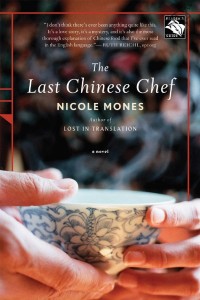 The Last Chinese Chef is probably my favorite of her novels. This time, Ms. Mones, a contributor to the now sadly defunct Gourmet magazine, takes us into the luscious world of Chinese cuisine.
The Last Chinese Chef is probably my favorite of her novels. This time, Ms. Mones, a contributor to the now sadly defunct Gourmet magazine, takes us into the luscious world of Chinese cuisine.
When Maggie McElroy, a widowed American food writer, learns of a Chinese paternity claim against her late husband’s estate, she has to go immediately to Beijing. She asks her magazine for time off, but her editor counters with an assignment: to profile the rising culinary star, Sam Liang, who is about to open an imperial-style restaurant in Beijing. When the restaurant opening is delayed Sam, who is half Chinese, half American, acts as Maggie’s translator and helps her track down the child and unravel the mystery of the parentage.
But readers – it’s the backdrop of the FOOD that is the heart and soul of this novel.
We understand the intricacies of Chinese cuisine. The concepts of texture and appearance are as important as flavor on the Chinese table. We learn about “guanxi” — the Chinese concept of relationships. We see that food is at the heart of Chinese relationships, one reason why all meals are shared in China and never individually plated. Chinese cuisine is very much about presentation including symbols and references which are understood instantly and connect its people not only to one another but to their culture and history.
This is not to say that the characters or the plot of The Last Chinese Chef aren’t compelling — oh they are. Sam, the heir to the family’s cooking expertise, is sexy yet gentle – helping Maggie comprehend the often mystifying Chinese culture and re-awakens her interest in food by preparing her luscious dishes (I know… sigh). Sam decides to enter a Chinese cooking competition and we watch, smell and taste the tapestry of the food he prepares to practice. Sam’s grandfather, Liang Wei, had been one of the last generation of chefs in the Forbidden City and the author of a highly regarded tome on the art of Chinese cuisine. Each chapter of the book starts with quotes of wisdom from this fictional but very realistic Chinese cook book. Eventually, Maggie and Sam unravel the truth behind the child’s parentage, but by then Maggie doesn’t care so much, re-awakened from her grief and happily eating.
+++++++++++++++++++++++
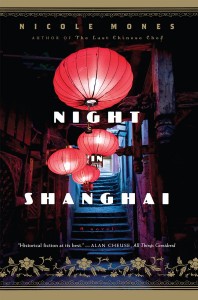 Night in Shanghai is Ms. Mone’s most recent novel. I haven’t read it, but it’s next on my list.
Night in Shanghai is Ms. Mone’s most recent novel. I haven’t read it, but it’s next on my list.
It’s about the little-known story of black musicians in the Chinese jazz age. You can watch the book’s trailer HERE.
(Who knew that one day book publishing/marketing includes film-style trailers.)
Independent Bookstore Day goes National May 2nd.
By Ron Charles April 30 Excerpted From the Washington Post

Find your local independent bookstore celebrations HERE
A brutal recession can change the economic landscape, but not always in the way people assumed it would. Six years ago, independent bookstores seemed destined to follow travel agents into the remainder bin. In 2009, the American Booksellers Association dipped down to 1,401 members. Borders shuttered hundreds of stores across the country, and Barnes & Noble started to teeter. If those big guys couldn’t survive, the conventional wisdom went, what chance did Mom & Pop Bookseller have?
It turns out, better than most of us expected. Despite the nation’s lackluster recovery, the number of indie bookstores has increased by more than a 25 percent since those dark days of 2009.
What accounts for this burst of literary entrepreneurialism?
Instead of heralding the industry’s doom, the death of Borders may have helped clear away competition. Other observers point to new interest in farmers markets and all things local. And maybe, like the prospect of hanging, the possibility of bankruptcy concentrated the minds of bookstore owners and inspired them to smarter, more creative merchandising.
However we got to this happy state, it’s worth celebrating, which is exactly the point of Independent Bookstore Day on Saturday, May 2. This new nationwide holiday stems from a program started last year by California indie bookstores. Now, more than 400 stores from Alaska to Maine are preparing for a full day of programs, entertainment and food to highlight their value.
Bradley Graham, co-owner of Politics & Prose, says, “Independent Bookstore Day is meant to celebrate all that indies stand for: personal service, author talks, the experience of browsing, the joy of discovery, a sense of community.”
Graham confirms that the industry-wide gloom of a few years ago has lifted. “Indies are definitely back,” he says, “with revenues rising and the number of stores increasing, as well. That’s a testament to how much people continue to value not only physical books but the local, community-oriented bookstores that sell them.”
Events director Sarah Baline describes the store’s business as healthy. “There seems to be a real increased awareness about the ‘shop local’ movement,” she says. “Customers come to us first, make us part of their routine. More people are coming to realize the value of independent businesses and want to become regulars.”For Baline, the secret is a diversified business model. “Independent bookstores are not just places to buy books,” she says. “We are community centers, gathering places and event spaces. Kramerbooks, especially with the full bar and restaurant, exemplifies the concept of a ‘third place’ for our community. A deep discount is no competition!”



















